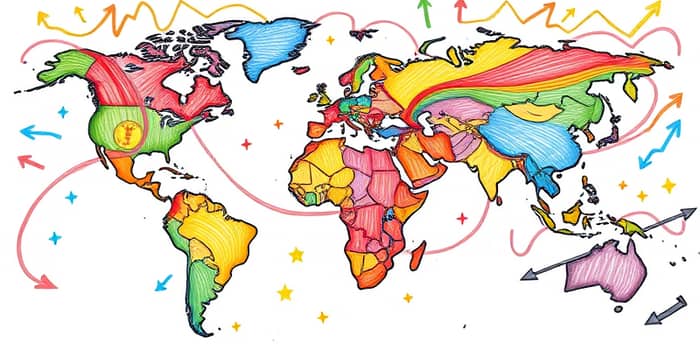
As economies emerge from the pandemic’s shadow and grapple with geopolitical shocks, the relentless rise in consumer prices has reshaped lives across the globe. From bustling metropolises to remote villages, households face the realities of heightened costs for essentials. This article explores the complex mosaic of inflation rates, dissecting the forces behind soaring numbers and offering insights to navigate an era marked by uncertainty and opportunity.
After peaking near 9% in late 2022, global consumer inflation eased to below 5% by late 2024. Yet the global average inflation rate hovers around 4.3% as of 2025, reflecting a mosaic of experiences: emerging markets endure roughly 5.5%, while advanced economies enjoy a milder 2.5%. Cumulative price surges since 2020 exceed 20% in many Western nations, while parts of Asia saw more modest increases under 10%.
This uneven recovery highlights the challenge for policymakers balancing growth with price stability. In advanced economies, central banks inch toward 2% targets, even as food and energy costs remain volatile. In contrast, emerging regions confront double-digit pressures driven by currency swings, fiscal strains, and supply disruptions.
This snapshot underscores the persistent supply chain disruptions and monetary reactions shaping prices worldwide.
While some regions approach stability, hotbeds of inflation persist. In Sub-Saharan Africa and Emerging Europe, rates exceed 13%, fueled by currency depreciation and fiscal strains. Latin America spans a wide spectrum—from moderate rates in Brazil to over 30% in Argentina. Asia remains a rarity with sub-3% figures, anchored by China’s slow demand and Japan’s cautious policies.
These outliers reveal the human toll of runaway prices and underscore the need for targeted interventions.
Understanding why inflation diverges demands a look at intertwined forces:
These factors interact uniquely in each region. While Europe contends with energy import vulnerabilities, Africa faces fiscal and foreign-exchange crises, and Asia benefits from resilient manufacturing and controlled price growth.
Despite gradual disinflation, several hazards could reverse gains. Tariff hikes by major economies threaten to ripple through global value chains, potentially adding up to 1% to core U.S. inflation. Divergent interest-rate paths may spur capital swings, destabilizing weaker currencies. Wage-price dynamics could intensify if labor markets stay tight, particularly in the U.S. and parts of Europe.
IMF forecasts suggest many countries will remain above 2% inflation through late 2025, indicating a cautious monetary stance is likely.
Confronting inflation requires both macro- and micro-level strategies. Central banks must maintain credibility, communication, and agility—calibrating policy to emerging data without choking growth. Governments should consider targeted fiscal measures, such as safety nets and well-designed subsidies, to shield vulnerable populations.
For businesses and households, proactive budgeting, diversified supply chains, and investment in productivity are vital. Consumers can manage budgets by seeking value options, embracing energy efficiency, and building emergency savings where possible.
Despite daunting statistics, history shows that inflationary episodes can be tamed with heightened monetary policy divergence when warranted, prudent fiscal safeguards, and international cooperation. By understanding regional dynamics and contributing factors, policymakers and citizens alike can forge resilient pathways toward stability.
The journey ahead may be challenging, but it also presents an opportunity: to rebuild systems that deliver sustainable growth, equitable prosperity, and price stability. In the face of rising costs, informed action and collective resolve can restore confidence and foster a more secure economic future for all.
References





